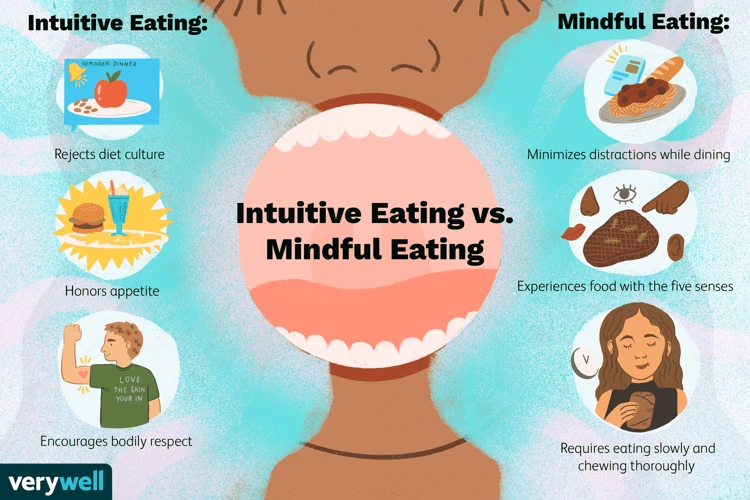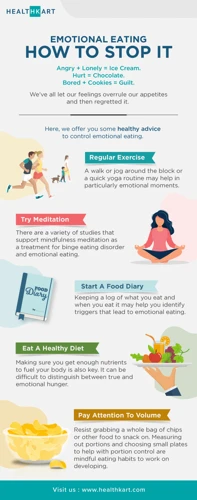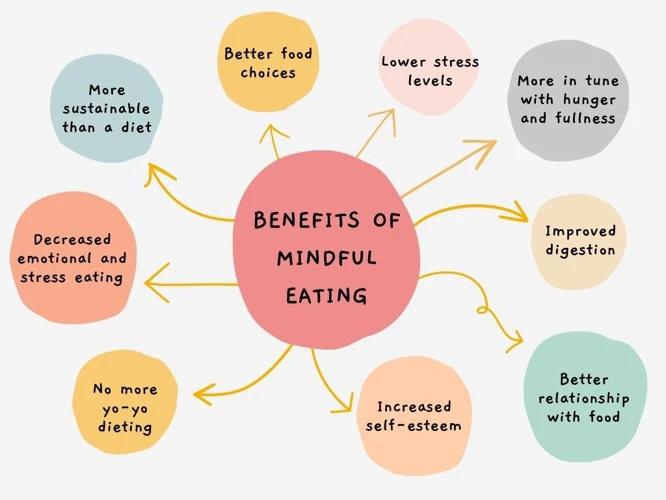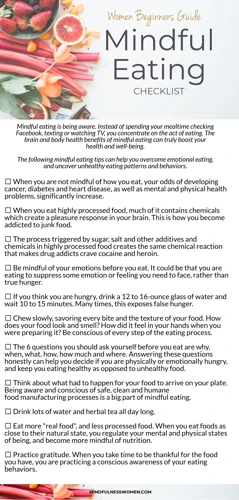As we go about our day-to-day lives, it’s not uncommon to turn to food for comfort during moments of stress or emotional turmoil. This mindless eating can easily become a habitual coping mechanism, leading to a cycle of emotional eating and weight gain. But what if we could break that cycle through the power of mindfulness? Enter mindful eating, a practice that can help us become more aware of our eating habits and make more intentional choices. In this article, we’ll explore the concept of mindful eating and how it can be utilized to overcome emotional eating habits. Let’s delve in!
What is Mindful Eating?

Have you ever had a meal and not even realized what you were eating because your mind was somewhere else? That’s the opposite of mindful eating. Mindful eating is the practice of being fully present and aware of your eating experience. It involves paying attention to the taste, texture, and smell of your food, as well as your body’s physical and emotional responses. It’s about cultivating a sense of curiosity and openness around food, rather than approaching it with rigid rules or restrictions. In this section, we’ll explore what mindful eating is and how it can help you overcome emotional eating habits.
Benefits of Mindful Eating
Mindful eating is a practice that can bring several benefits to both physical and mental health. By incorporating mindfulness into eating habits, one can become more aware of their eating patterns, cultivate a sense of compassion towards themselves, and improve overall well-being. Some of the key benefits of mindful eating include:
- Weight management: Mindful eating can help prevent overeating and promote healthier food choices. It can also reduce the likelihood of binge eating and emotional eating habits, which can contribute to weight gain.
- Better digestive health: By slowing down and paying attention to the process of eating, mindful eating can improve digestion and reduce symptoms of gastrointestinal disorders such as bloating, constipation, and heartburn.
- Improved mental health: Mindful eating can help individuals become more aware of their emotional states, allowing them to develop healthier responses to stress, anxiety, and depression. By reducing stress levels and improving mood, mindful eating can contribute to overall mental well-being.
- Increased satisfaction: By savoring each bite and truly enjoying the sensory experience of eating, individuals can derive greater pleasure and satisfaction from their meals. Mindful eating can help individuals appreciate food on a deeper level and develop a greater sense of gratitude for the nourishment it provides.
- Enhanced self-awareness: By paying attention to bodily sensations and emotions during eating, individuals can develop a heightened sense of self-awareness. This can lead to a greater understanding of one’s hunger and fullness cues, as well as an increased ability to recognize emotional triggers for overeating.
Incorporating the practice of mindful eating into one’s life can bring a range of physical, mental, and emotional benefits, making it a valuable tool for promoting overall health and well-being.
What is Emotional Eating?

Do you ever find yourself reaching for a pint of ice cream or a bag of chips after a long, stressful day? Emotional eating is a common response to difficult emotions, such as sadness, anxiety, and boredom. It involves eating not because you are hungry, but as a way to cope with negative feelings. Emotional eating can quickly turn into a habit that can be hard to break, leading to weight gain and negative effects on both our physical and mental health. In this next section, we will explore what triggers emotional eating and how mindful eating can help overcome this harmful habit.
Triggers for Emotional Eating
Emotional eating is a behavior in which individuals turn to food as a coping mechanism for dealing with difficult emotions or stress. Such emotions can be triggered by various factors that may result in binge eating, snacking, or overeating. Below are some common triggers that lead to emotional eating:
- Stress: Stressful situations at work, home, or within relationships often trigger emotional eating. The cortisol hormone released in response to stress causes a rise in appetite and cravings for comfort foods.
- Depression: Feelings of sadness, hopelessness, or loss of interest in activities that were once pleasurable are common factors that lead to emotional eating. Food becomes a source of comfort and pleasure to temporarily alleviate negative emotions.
- Anxiety: Feelings of fear, nervousness, or worry often result in emotional eating as a means of coping with the uncomfortable sensations in the body. Stress-eating can lead to a vicious cycle of anxiety, guilt, and overeating.
- Boredom: Boredom is a common emotional trigger for unhealthy eating habits. Eating provides a distraction from the mundane routine, and often brings temporary pleasure and satisfaction.
- Loneliness: Feelings of loneliness, insecurity or disconnection can lead to emotional eating. Food can provide an escape from the isolation and bring a sense of comfort and security.
- Tiredness: Fatigue often triggers emotional eating as individuals seek quick fixes to stay awake and alert. Consuming sugary and high-fat foods can provide temporary energy boosts, but often lead to a cycle of crashing and cravings for more unhealthy food.
Identifying the triggers that lead to emotional eating can help individuals be more mindful and aware of their eating habits, enabling them to find healthier ways to cope with difficult emotions.
How to Use Mindful Eating to Overcome Emotional Eating Habits

Do you find yourself reaching for snacks or overeating when you’re feeling stressed or emotional? If so, you’re not alone – many people turn to food as a way to cope with difficult emotions. This type of eating is known as emotional eating, and it can be a difficult habit to break. However, one approach that has been shown to be effective is using mindful eating techniques. By paying attention to your body and being present in the moment while you eat, you can learn to overcome emotional eating habits and create a healthier relationship with food. Let’s explore some practical steps you can take towards more mindful eating.
1. Practice Mindful Awareness of Hunger and Fullness
One of the key aspects of using mindful eating to overcome emotional eating habits is to practice mindful awareness of our hunger and fullness cues. We often eat out of habit or in response to emotions, rather than in response to our actual physical need for fuel.
To become more mindful of our hunger and fullness cues, we can use the following techniques:
| 1. | Pause before eating to check in with our bodies and assess our level of hunger. Are we truly hungry, or are we eating out of habit or in response to an emotion? |
| 2. | Eat slowly and pay attention to how our food tastes, smells, and feels in our mouth. This allows us to more easily notice when we start to feel full. |
| 3. | Stop eating when we are comfortably full, rather than continuing to eat until we feel overstuffed or uncomfortable. |
| 4. | Notice any discomfort or unpleasant sensations in our body that might indicate we’ve overeaten or eaten too quickly. |
By practicing mindful awareness of our hunger and fullness cues, we can develop a deeper understanding of our body’s needs and become more attuned to the signals it is sending us. This can help us to make better choices about when, what, and how much to eat, and can reduce the likelihood of eating in response to emotions rather than true physical need.
2. Identify Emotional Triggers and Responses
One of the key steps in using mindful eating to overcome emotional eating habits is identifying your emotional triggers and responses. These triggers can be anything from stress at work to relationship problems, and they can cause you to reach for unhealthy foods as a way of coping. By identifying your triggers and responses, you can take action to break the cycle of emotional eating and develop more positive coping strategies.
Here’s how to identify your emotional triggers and responses:
| Step | Explanation |
|---|---|
| 1. Keep a food and mood journal | Record what you eat, when you eat it, and how you feel before and after eating. Look for patterns to determine what emotional triggers may be causing you to overeat or choose unhealthy foods. |
| 2. Pay attention to your thoughts and feelings | Take note of any negative thoughts or emotions you experience throughout the day. When you experience these thoughts or emotions, do you feel the urge to eat? If so, this may be an emotional trigger for you. |
| 3. Practice mindfulness | When you feel the urge to eat, take a moment to pause and practice mindfulness. Tune into your body and emotions, and try to identify what you’re feeling and why. This can help you become more aware of your emotional triggers and responses. |
| 4. Seek support | Don’t be afraid to reach out for support if you’re struggling to identify your emotional triggers and responses. Consider working with a therapist or counselor who can help you develop healthy coping strategies. |
By identifying your emotional triggers and responses, you can take steps to avoid or minimize the triggers and develop healthier coping strategies. This can ultimately help you break the cycle of emotional eating and develop a healthier relationship with food.
3. Cultivate Self-Compassion and Forgiveness
Forgiving oneself for past mistakes is an essential step in overcoming emotional eating habits. It can be challenging to break the cycle of negative self-talk and feelings of guilt that often accompany emotional eating. However, cultivating self-compassion and forgiveness is an important part of the process.
Here are some ways to cultivate self-compassion and forgiveness:
- Practice self-reflection: Take a few minutes every day to reflect on your feelings and thoughts. Be gentle with yourself and observe your emotions without judgment.
- Be kind to yourself: Treat yourself as you would treat a friend. Speak to yourself with kindness and compassion.
- Let go of perfectionism: No one is perfect, and it’s okay to make mistakes. Recognize that progress, not perfection, is the goal.
- Focus on the present moment: Mindful eating encourages focusing on the present moment and being fully engaged in the experience. This approach can help you let go of past mistakes and focus on the present moment.
- Acknowledge progress: Celebrate small victories along the way. Recognize that every step forward is a step in the right direction.
- Forgive yourself: Recognize that everyone makes mistakes and practice forgiving yourself for past emotional eating episodes. Let go of negative thoughts and emotions that keep you trapped in the cycle of emotional eating.
Cultivating self-compassion and forgiveness may take some time and practice, but it’s an essential step in breaking free from emotional eating habits. Be patient with yourself and remember that every small step forward counts.
Mindful Eating Techniques to Try

As you begin incorporating mindful eating into your daily routine, there are several techniques you can try to enhance your practice. These techniques are designed to bring a deeper level of awareness to your eating habits and help you overcome emotional eating patterns. Consider trying these mindful eating techniques to fully immerse yourself in the experience and reap the benefits of this powerful practice.
1. Slow Down and Savor
When practicing mindful eating to overcome emotional eating habits, it’s important to slow down and savor each bite. This means taking the time to fully experience the taste, texture, and aroma of your food.
This technique has several benefits:
| Benefits of Slow and Savory Eating |
|---|
| Helps you better appreciate your food |
| Allows you to fully experience the flavors and textures |
| Encourages you to take smaller bites and chew more slowly |
| Helps you feel more satisfied with smaller portions |
To practice this technique, take a bite of food and put your utensil down. Savor the taste and texture for a few seconds before taking your next bite. You may also want to try closing your eyes and focusing solely on the flavor of the food.
When you slow down and savor your food, you’re able to fully enjoy and appreciate each bite. This can help you feel more satisfied with smaller portions and reduce the likelihood of overeating. Additionally, taking the time to savor your food can help you better regulate your emotions and prevent emotional eating habits.
2. Practice Gratitude and Appreciation
In addition to slowing down and savoring your food, practicing gratitude and appreciation can also be helpful in cultivating a more mindful approach to eating. By taking a moment to acknowledge and express gratitude for your food, you can shift your focus away from negative emotions and towards more positive ones.
One way to practice gratitude is to simply take a moment to silently or aloud express thanks for your meal or for the individuals who contributed to its preparation. You can also take the time to appreciate the appearance, aroma, and taste of the food you are eating, truly savoring each bite. Gratitude can help you develop a greater sense of connection to your food and the individuals who made it possible for you to enjoy it.
Here is a table summarizing some ways to practice gratitude and appreciation during mealtimes:
| Technique | Description |
|---|---|
| A Moment of Thanks | Express gratitude silently or aloud before beginning your meal. |
| Appreciation of Sensory Experience | Notice and savor the appearance, aroma, and taste of each bite. |
| Reflect on the Journey of Your Food | Consider the individuals and processes involved in bringing your food to your plate. |
| Pay it Forward | Consider ways you can show kindness and generosity towards others through your relationship with food. |
By practicing gratitude and appreciation during mealtimes, you can increase your awareness and enjoyment of the food you are eating while also cultivating a more positive mindset. This can help reduce the likelihood of turning to emotional eating as a coping mechanism when negative emotions arise.
3. Use All Your Senses
One effective technique for practicing mindful eating is to use all your senses. By engaging all your senses, you can fully experience your food and your body’s response to it.
Here are some ways to use each sense during meals:
| Sense | How to Use It |
| Sight | Observe the colors, shapes, and textures of your food. Notice the presentation and arrangement of the food on your plate. |
| Sound | Listen to the sounds of your food as you chew and swallow. Pay attention to the sounds of your surroundings. |
| Smell | Take a deep breath and smell your food before taking a bite. Notice the aroma and how it makes you feel. |
| Taste | Savor the flavors and textures of your food. Chew slowly and mindfully, allowing the flavors to fully develop. |
| Touch | Feel the texture, temperature, and weight of your food in your hands and mouth. Pay attention to the sensation of food moving through your body. |
Using all your senses while eating can help you fully engage with your food and the experience of eating. It can also help you tune in to your body’s cues of hunger and fullness and make more mindful eating choices.
4. Chew Thoroughly and Mindfully
To fully practice mindful eating, it’s important to focus on the act of chewing your food. Oftentimes, we eat quickly and don’t fully chew our food before swallowing. This can lead to overeating and digestive issues. By intentionally chewing each bite of food thoroughly and mindfully, we can improve our digestion and appreciate the flavors and textures of our meals.
Why should we chew thoroughly and mindfully?
Chewing thoroughly breaks down our food into smaller pieces, making it easier to digest. It also sends signals to our brain that we are eating, helping to regulate our appetite and prevent overeating. Additionally, chewing mindfully allows us to fully experience the taste and texture of our food, enhancing our enjoyment of meals.
How to chew thoroughly and mindfully:
| Step | Description |
|---|---|
| 1 | Take a small bite of food |
| 2 | Put your utensil down |
| 3 | Chew the food slowly and thoroughly, focusing on the sensation of chewing |
| 4 | Pay attention to the taste, texture, and flavor of the food |
| 5 | Swallow the food only when it has been fully chewed |
| 6 | Repeat with each bite, taking breaks and checking in with your body’s hunger and fullness signals |
By chewing thoroughly and mindfully, we can improve our digestion and fully appreciate the tastes and textures of our food. Give it a try during your next meal or snack!
5. Take Breaks and Check In
One effective technique for using mindful eating to overcome emotional eating habits is to take breaks and check in with yourself throughout your meal. This can help you become more aware of your body’s hunger and fullness signals, as well as any emotions or thoughts that may be driving your eating behavior.
Here are some steps you can take to incorporate this technique into your mindful eating practice:
- Pause. Set a timer for a few minutes, and take a break from eating. This can help you become more mindful and attentive to your bodily sensations, thoughts, and emotions.
- Check in with your hunger and fullness signals. Take note of how hungry or full you feel on a scale from 1-10. This can help you become more attuned to your body’s natural cues and avoid overeating or undereating.
- Check in with your emotions. Take a moment to reflect on any emotions or thoughts that may be influencing your eating behavior. Are you eating because you’re stressed, anxious, or bored? Acknowledging these emotions can help you become more aware of your triggers and develop more effective coping strategies.
- Reassess your eating goals. Take a moment to review your reasons for practicing mindful eating and your long-term goals. This can help you stay focused and motivated, even when faced with challenging emotions or situations.
- Resume eating mindfully. After taking a few moments to check in with yourself, take a few deep breaths and resume eating mindfully. Remember to savor your food, chew thoroughly, and engage all your senses as you eat.
By taking breaks and checking in with yourself throughout your meal, you can develop a greater sense of self-awareness and begin to break free from emotional eating patterns. With practice, this technique can become a habit that helps you cultivate a healthier, more joyful relationship with food.
6. Remove Distractions
When practicing mindful eating to overcome emotional eating habits, it’s important to minimize distractions at meal times. This means turning off the television, putting away your phone, and finding a quiet place to eat. By removing distractions, you can fully focus on the food and the experience of eating.
Here are some ways to remove distractions during meal times:
- Designate a specific eating space: If possible, designate a specific area in your home for eating. This can be a dining table or even a specific corner of your kitchen. By creating a designated space, you can separate eating from other activities and minimize distractions.
- Turn off electronic devices: Electronic devices such as phones, tablets, and televisions can be major distractions during meal times. Turning off these devices can help you stay present with your food and the act of eating.
- Eat in silence: If you live with others, it can be tempting to chat and catch up during meals. However, this can be a major distraction from the act of eating. Try eating in silence to fully focus on the food and your body’s signals of hunger and fullness.
- Avoid multitasking: It can be tempting to try to get work done or watch a show while eating, but this can lead to mindless eating and overconsumption. To fully enjoy your meal and tune in to your body’s signals, avoid multitasking while eating.
By removing distractions, you can fully engage in the experience of eating and recognize the emotions or triggers that may come up during meal times. This can help you develop a more positive and mindful relationship with food.
Benefits of Using Mindful Eating to Overcome Emotional Eating Habits

Practicing mindful eating can be an effective tool for overcoming emotional eating habits. By being present and aware of our thoughts and emotions while we eat, we can better understand and manage our triggers for overeating. Some benefits of using mindful eating to overcome emotional eating habits include:
1. Improved Awareness: Practicing mindful eating helps us become more aware of our hunger and fullness cues, which can help prevent overeating due to emotional triggers.
2. Decreased Stress: When we are more present and aware while eating, we are less likely to turn to food as a form of stress relief. This can lead to a decrease in overall stress levels.
3. Greater Resilience: Mindful eating helps us develop greater resilience in the face of emotional stressors. Rather than turning to food as a coping mechanism, we can learn to better manage our emotions and find more effective ways of coping.
4. Improved Relationship with Food: By practicing gratitude and appreciation for our food, we can develop a healthier and more positive relationship with food.
5. Increased Mindfulness in Other Areas: By practicing mindful eating, we can develop greater mindfulness in other areas of our lives as well. This can lead to a greater sense of overall well-being.
Using mindful eating as a tool for overcoming emotional eating habits can have numerous physical, emotional, and psychological benefits. It can help us develop a healthier relationship with food, manage our emotions more effectively, and improve our overall well-being.
Tips for Getting Started with Mindful Eating
Starting on the path of mindful eating can be daunting, especially when you have spent years engaging in emotional eating habits. However, with a few simple tips, you can begin to incorporate mindful eating practices into your daily routine and slowly overcome your emotional eating habits.
1. Start small: Don’t try to overhaul your entire eating habits all at once – this can lead to frustration and burnout. Instead, start with incorporating mindful eating practices into one meal or snack per day.
2. Learn to listen to your body: Our bodies are incredibly intelligent and can communicate with us about what they need. Learn to tune in to your body’s cues for hunger and fullness.
3. Keep a food journal: Writing down what you eat, when you eat, and how you feel before and after can help you identify patterns in your eating habits and emotional triggers.
4. Find support: Join a support group or seek out the help of a therapist or registered dietitian who can provide guidance and accountability on your mindful eating journey.
5. Practice self-compassion: Be gentle with yourself, acknowledge that change takes time and it’s okay to have setbacks. Focus on progress, not perfection.
6. Choose whole, nourishing foods: Choosing nutrient-dense foods can help nourish your body and reduce the likelihood of emotional eating.
Remember, mindful eating is a journey and not a destination. Incorporating just a few of these tips into your routine can make a big difference in your relationship with food and help you overcome emotional eating habits.
Conclusion
In conclusion, mindful eating can be a powerful tool in overcoming emotional eating habits. By practicing awareness of both physical hunger and emotional triggers, individuals can learn to make more intentional and nourishing choices about what they eat.
The benefits of mindful eating extend beyond just weight management, with research showing improvements in digestion, mood, and overall well-being.
Implementing mindful eating techniques, such as slowing down and savoring food, using all your senses while eating, and removing distractions, can help individuals fully engage with their food and cultivate a greater appreciation for the nourishment it provides.
However, implementing mindful eating habits can take time and patience, and it’s important for individuals to practice self-compassion and forgiveness as they work to overcome emotional eating patterns.
Getting started with mindful eating may feel overwhelming, but small steps such as checking in with hunger and fullness levels or identifying emotional triggers can make a big difference. By making gradual changes and finding techniques that work for them, individuals can use mindful eating to improve their relationship with food and ultimately lead a happier, healthier life.
Frequently Asked Questions
What if I struggle with recognizing emotional eating triggers?
It may be helpful to keep a food journal and note the circumstances and emotions surrounding meals and snacks. Consulting with a therapist or counselor may also provide insight and support.
Do I have to give up my favorite foods to practice mindful eating?
No, mindful eating is not about deprivation or restriction. It is about allowing yourself to enjoy food in a more conscious and satisfying way.
How can I make time for mindful eating in a busy schedule?
Start small with one meal or snack per day, and gradually increase as you feel comfortable. It can also be helpful to set aside specific times for meals and snacks, and to minimize distractions during that time.
What if I slip up and engage in emotional eating again?
It’s important to practice self-compassion and forgiveness. Every day and every meal is an opportunity to try again and refocus on mindful eating habits.
What are some examples of non-food ways to cope with emotional triggers?
Engaging in physical activity, practicing relaxation techniques, seeking support from loved ones, and journaling are all examples of non-food coping strategies
Can mindful eating help with weight loss?
While weight loss is not the primary focus of mindful eating, some studies have suggested that practicing mindful eating may lead to a decrease in overall food intake and an increase in satisfaction with smaller portions.
How long does it take to see results from practicing mindful eating?
Results may vary, but research suggests that noticeable changes in eating habits and attitudes towards food may begin to emerge within a few weeks of practicing mindful eating.
Can mindful eating benefit my mental health?
Yes, many individuals report feeling increased mindfulness and reduced stress levels when incorporating mindful eating practices into their lives. Additionally, addressing emotional eating habits may have a positive impact on overall psychological wellbeing.
What if I have a medical condition that requires strict dietary restrictions?
It is important to work with a healthcare provider or registered dietitian to ensure that any dietary restrictions are being met while also practicing mindful eating habits.
How can I incorporate mindful eating practices into my social life?
You can still engage in social eating while also practicing mindful eating. Savoring each bite, engaging in conversation instead of mindlessly eating, and being aware of your hunger and fullness cues can all be incorporated into social eating situations.







